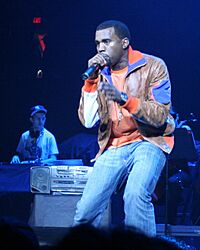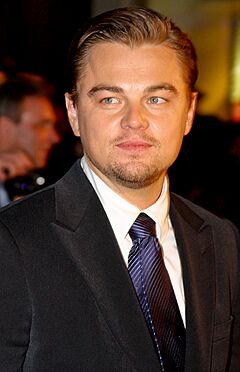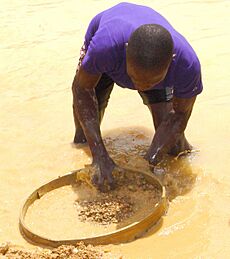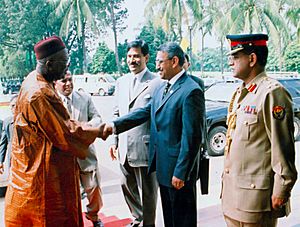Sierra Leone Civil War facts for kids
Quick facts for kids Sierra Leone Civil War |
|||||||
|---|---|---|---|---|---|---|---|
| Part of spillover of the First and Second Liberian Civil Wars | |||||||
|
|||||||
| Belligerents | |||||||
|
Foreign mercenaries Supported by: |
||||||
| Commanders and leaders | |||||||
| Strength | |||||||
ECOMOG: ~700 Nigerian soldiers |
|||||||
| Casualties and losses | |||||||
| 50,000 to 70,000 deaths 2.5 million displaced internally and externally |
|||||||
The Sierra Leone Civil War (1991–2002) was a long and difficult conflict in Sierra Leone. It lasted for almost 11 years. During this time, between 50,000 and 70,000 people died. About 2.5 million people had to leave their homes.
Contents
Why the War Started
Sierra Leone's Political Problems
Sierra Leone became independent from the United Kingdom in 1961. After its first leader, Sir Milton Margai, died in 1964, the country faced many problems. There was a lot of corruption and poor management. Elections were often violent. This led to a weak society and a failing education system.
By 1991, many young people were unhappy. They were drawn to the message of the Revolutionary United Front (RUF). This group promised change and many joined them. Leaders like Albert Margai used their power for personal gain. They even used the military to stop fair elections.
When Siaka Stevens became a leader in 1968, Sierra Leone was a democracy. But when he left 17 years later, it was a one-party state. Stevens damaged many government systems. He weakened the parliament and bribed judges. He also spent the country's money on projects that only helped his friends. If opponents did not cooperate, he would punish them harshly or force them to leave the country.
In 1985, Stevens stepped down. He handed power to Major General Joseph Momoh. Momoh inherited a very weak economy. He tried to stop corruption in his government. But the country was so poor that it could not pay its workers. People even looted government offices. Basic things like gasoline were hard to find.
The worst problem was when the government could not pay school teachers. The education system collapsed. Only rich families could afford private teachers. This meant many young people had nothing to do. Many skilled people left Sierra Leone. By 1991, Sierra Leone was one of the poorest countries. This was despite having many natural resources like diamonds and gold.
Diamonds and Their Role in Conflict
The eastern and southern parts of Sierra Leone have many alluvial diamonds. These diamonds are easy to find with simple tools. Since they were found in the 1930s, diamonds have often funded corruption. They helped leaders get rich instead of improving public services. When a country has many natural resources but stays poor, it is called the "resource curse".
Diamonds played a big part in starting the civil war. First, ordinary people were frustrated because only a few people benefited from diamond mining. Under Stevens' rule, money from the National Diamond Mining Corporation went to him and his close friends. When the company left in 1984, the government lost control of the diamond areas.
By the late 1980s, most diamonds were smuggled. The money went to private investors. This trade was controlled by Lebanese and later Israeli traders. Momoh tried to stop the smuggling. But he did not have enough power to enforce the law. Even after a new government took over in 1992, leaders still sold diamonds for their own gain.
Diamonds also helped the RUF rebels get weapons. They used diamond money to buy guns from nearby countries. The easy access to diamonds also encouraged violence. To control important mining areas, thousands of people were forced out of their homes.
While diamonds were a major cause, other things also fueled the war. Gold mining was important in some areas. Also, forced labor was used to grow cash crops. Looting was not just about diamonds. Rebels stole money, household items, food, and cars. For people who had no land, joining the rebels was a way to take property by force.
However, the war was not just about diamonds. Over 20 years of bad leadership, poverty, and unfairness created the RUF. People wanted change.
How the War Unfolded
On March 23, 1991, the Revolutionary United Front (RUF) entered Sierra Leone. They had help from Liberian leader Charles Taylor's forces. Their goal was to overthrow the government of Joseph Momoh.
In the first year, the RUF took control of many areas rich in diamonds. The government could not stop them. This led to a military takeover in April 1992. A group called the National Provisional Ruling Council (NPRC) took power. By late 1993, the Sierra Leone Army (SLA) pushed the RUF back. But the RUF fought back, and the war continued.
In March 1995, a private military company from South Africa, Executive Outcomes, was hired. They helped push back the RUF. Sierra Leone then held elections in March 1996. A new civilian government was elected. The RUF signed a peace agreement called the Abidjan Peace Accord. But under pressure from the United Nations, the government ended its contract with Executive Outcomes. The fighting then started again.
In May 1997, some unhappy SLA officers took over the government. They formed the Armed Forces Revolutionary Council (AFRC). The RUF joined them and easily captured the capital city, Freetown. The new government, led by Johnny Paul Koroma, said the war was over. But then, there was a lot of looting and violence.
Other countries were upset about the civilian government being overthrown. Forces from the Economic Community of West African States Monitoring Group (ECOMOG) stepped in. They took Freetown back for the government. But it was harder to control the areas outside the city.
In January 1999, world leaders helped arrange talks between the RUF and the government. This led to the Lome Peace Accord, signed on March 27, 1999. This agreement made Foday Sankoh, the RUF commander, the vice president. He also got control of Sierra Leone's diamond mines. In return, the fighting was supposed to stop. A UN peacekeeping force (United Nations Mission in Sierra Leone, UNAMSIL) was sent to oversee the disarmament.
However, the RUF did not fully follow the disarmament plan. By May 2000, the rebels were moving towards Freetown again. As the UN mission struggled, the United Kingdom decided to help. They intervened to support the weak government of President Ahmad Tejan Kabbah. With new UN support and help from Guinea, the British Operation Palliser finally defeated the RUF. They took back control of Freetown. On January 18, 2002, President Kabbah declared the Sierra Leone Civil War officially over.
Life After the War
Troop Withdrawal
On July 28, 2002, the British military left Sierra Leone. They had been there since 2000. They left behind a small team to train the Sierra Leone Army and Navy. In November 2002, the UNAMSIL peacekeeping force began to leave. They had been 17,800 strong. The British asked them to slow down their departure. So, by October 2003, there were still 12,000 UN troops.
As peace continued in 2004, UNAMSIL reduced its forces to about 4,100 by December. The UN Security Council extended UNAMSIL’s mission until December 2005. All UN troops left in December 2005. A new UN office, UNIOSIL, took over.
Truth and Reconciliation
The Lome Peace Accord called for a Truth and Reconciliation Commission. This group allowed victims and those who committed wrongs during the war to share their stories. The goal was to help people heal.
Later, the Sierra Leonean government asked the UN to help create a Special Court for Sierra Leone. This court would try those most responsible for serious crimes during the war. Both the Truth and Reconciliation Commission and the Special Court started in mid-2002.
Rebuilding the Country
Helping People Recover
After the war, many children had been forced to fight. They needed help to recover. Only a few could go home right away. Many suffered from brainwashing and physical or mental injuries. Some even forgot who they were before the war.
About one to two million people had been displaced. They needed to return to their villages.
Rebuilding Villages and Services
Thousands of small villages were badly damaged. Homes were looted and destroyed. Clinics and hospitals were also heavily damaged. This caused worries about the country's basic services.
Government Support
The European Union (EU) provided financial support to Sierra Leone. This was done with help from the IMF, World Bank, and the UK. The goal was to stabilize the economy and government. The EU gave €4.75 million from 2000 to 2001. This money helped the government pay for social services. After help from the Bangladesh UN Peacekeeping Force, the government declared Bengali an honorary official language in December 2002.
Diamond Money After the War
Diamond earnings in Sierra Leone greatly increased after the war. They went from $10 million in 2000 to about $130 million in 2004. However, surveys showed that over half of diamond mining was still unlicensed. A lot of illegal diamond smuggling continued.
The War in Movies and Books
The Sierra Leone Civil War has been shown in many films and books.
In 2000, journalist Sorious Samura released his film Cry Freetown. This documentary showed the brutal period when RUF rebels took the capital city. It also showed the fight by ECOMOG and government forces to take it back. The film won several awards.
The documentary Sierra Leone's Refugee All Stars tells the story of refugees. They fled to Guinea and formed a band. Music helped them cope with the difficulties of war.

The song "Diamonds from Sierra Leone" by American rapper Kanye West is about the war. It focuses on "conflict diamonds," which are diamonds sold to fund wars. West was inspired after learning how diamond sales fueled the war. The song won a Grammy Award.

The 2006 movie Blood Diamond also uses the civil war as its background. It stars Leonardo DiCaprio. Another movie, Lord of War, shows a character selling weapons to groups during the civil war.
The use of children as soldiers is shown in Ishmael Beah's 2007 book, A Long Way Gone.
Mariatu Kamara wrote The Bite of the Mango. In her book, she describes being attacked by rebels and having her hands cut off. Ishmael Beah wrote the introduction to her book.
The 2012 documentary La vita non perde valore features former child soldiers. They talk about their lives ten years after the war. It shows how they are recovering with help from an Italian missionary.
Jonathon Torgovnik wrote Girl Soldier: Life After War in Sierra Leone. This book shares the experiences of eight women. They were kidnapped during the war and forced to fight.
Images for kids
See also
- Burundian Civil War
- Second Congo War
- Second Liberian Civil War







